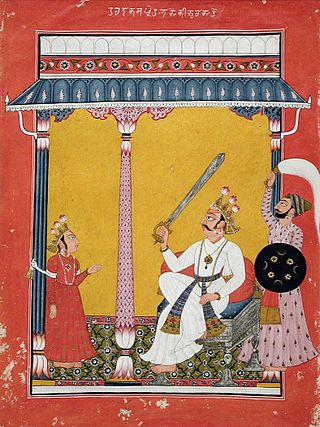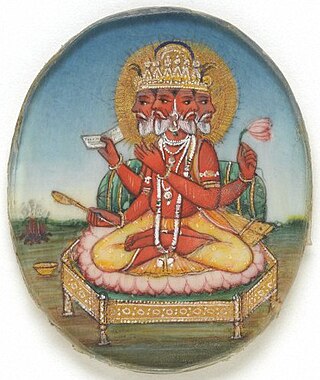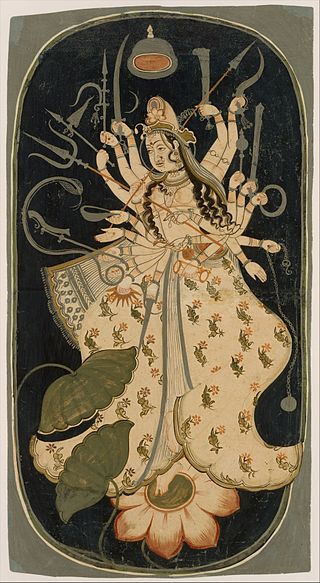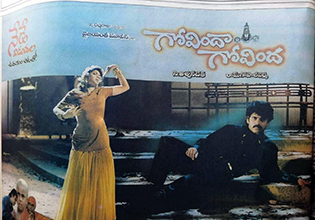
The Trimūrti are the trinity of supreme divinity in Hinduism, in which the cosmic functions of creation, preservation, and destruction are personified as a triad of deities. Typically, the designations are that of Brahma the creator, Vishnu also known as Jagannath the preserver, and Shiva the destroyer. The Om symbol of Hinduism is considered to have an allusion to Trimurti, where the A, U, and M phonemes of the word are considered to indicate creation, preservation and destruction, adding up to represent Brahman. The Tridevi is the trinity of goddess consorts for the Trimurti.

Shesha, also known by his epithets Sheshanaga and Adishesha, is a serpentine demigod (naga) and Nagaraja, as well as a primordial being of creation in Hinduism. In the Puranas, Shesha is said to hold all the planets of the universe on his hoods and to constantly sing the glories of Vishnu from all his mouths. He is sometimes referred to as Ananta Shesha, "Endless-Shesha", or Adishesha, the "First Shesha". It is said that when Adishesa uncoils, time moves forward and creation takes place; when he coils back, the universe ceases to exist.

Hiranyakashipu, also known as Hiranyakashyap, is an asura king of the daityas in the Puranic scriptures of Hinduism.

Vamana, also known as Trivikrama, Urukrama (transl. far-stepping), Upendra, Dadhivamana, and Balibandhana is an avatar of the Hindu deity Vishnu. He is the fifth avatar of Vishnu, and the first Dashavatara in the Treta Yuga, after Narasimha.

Narayana is one of the forms and epithets of Vishnu. In this form, the deity is depicted in yogic slumber under the celestial waters, symbolising the masculine principle and associated with his role of creation. He is also known as Purushottama, and is considered the Supreme Being in Vaishnavism.

Mahavishnutransl. 'Great Vishnu' is an aspect of Vishnu, the principal deity in Vaishnavism. In his capacity as Mahavishnu, the deity is known as the Supreme Purusha, the absolute protector and sustainer of the universe, the one who is beyond human comprehension, and all attributes.

Kaumodaki is the gadā (mace) of the Hindu deity Vishnu. Vishnu is often depicted holding the Kaumodaki in one of his four hands; his other attributes are the chakra, the conch, and the lotus. The gada is also found in the iconography of some of Vishnu's avatars.

Sthalasayana Perumal Temple is a Hindu temple dedicated to the god Vishnu located near Kollumangudi, Tamil Nadu, India. It is located 2 km away from Kollumangudi, 40 km away from Kumbakonam and 10 km from Karaikal. Constructed in the Dravidian style of architecture, the temple is glorified in the Nalayira Divya Prabandham, the early medieval Tamil canon of the Alvar saints from the 6th–9th centuries CE. It is one of the 108 Divya Desams dedicated to Vishnu, who is worshipped as Sthalasayana Perumal and his consort Lakshmi as Thirumagal Nachiyar. A granite wall surrounds the temple, enclosing all the shrines. There is a four-tiered rajagopuram, the temple's gateway tower, in the temple.
Para Brahman or Param Brahman in Hindu philosophy is the "Supreme Brahman" that which is beyond all descriptions and conceptualisations. It is described as the formless that eternally pervades everything, everywhere in the universe and whatever is beyond.

Vishnu, also known as Narayana and Hari, is one of the principal deities of Hinduism. He is the supreme being within Vaishnavism, one of the major traditions within contemporary Hinduism.

Brahma is a Hindu god, referred to as "the Creator" within the Trimurti, the trinity of supreme divinity that includes Vishnu and Shiva. He is associated with creation, knowledge, and the Vedas. Brahma is prominently mentioned in creation legends. In some Puranas, he created himself in a golden embryo known as the Hiranyagarbha.

Akrura is a Yadava prince in Hinduism, best known for being the uncle of the deity Krishna. The son of Śvaphalka and Gandini, a daughter of the king of Kashi, he is instructed by Kamsa to drive his nephews, Krishna and Balarama, to a Dhanuryāga at Mathura, where they were to be slain. He bears witness to the vishvarupa (theophany) of Krishna during this journey. Akrura becomes the owner of the Syamantaka jewel after the death of its previous owner, Satrajit. He is slain during the internecine Yadu massacre at Prabhasa.

Janardana Swami Temple is a 2000+ year-old temple situated in the municipality of Varkala city in Thiruvananthapuram district. It is also known as Varkala Temple. Janardana Swami is a form of Vishnu. It is a very well-known temple in Kerala, about 10.9 km west of Kallambalam on NH 66 near the sea, 25 km north of Thiruvananthapuram city, 8 km south of famous backwater destination Kappil and 2 km from Varkala Railway Station,14 km north west of Attingal municipality. It is situated near the Arabian Sea and has been referred to as Dakshin Kashi. The temple is near Varkala Beach, believed to have medicinal properties since the waters wash the nearby medicinal plants. It is also an important Ayurveda treatment center. The temple has an ancient bell removed from a shipwreck, donated by the captain of a Dutch vessel which sank near Varkala without casualties.

Mahadevi, also referred to as Adi Parashakti,Adi Shakti, and Abhaya Shakti, is the supreme goddess in the Shaktism sect of Hinduism. According to this tradition, all Hindu goddesses are considered to be manifestations of this single great Goddess, who is comparable to the deities Vishnu and Shiva as Para Brahman. Vaishnavas consider her to be Lakshmi, Shaivas consider her to be Parvati, Durga, Lalita and Kali, while Shaktas consider her to be Durga, Tripura Sundari, Bhuvaneshvari, and Kali. Author Helen T. Boursier says: "In Hindu philosophy, both Lakshmi and Parvati are identified with the great goddess—Mahadevi—and the Shakti or divine power".

Pandavatutar Perumal Temple or Thirupadagam located in Kanchipuram in the South Indian state of Tamil Nadu, is dedicated to the Hindu god Krishna, an avatar of the god Vishnu. Constructed in the Dravidian style of architecture, the temple is glorified in the Nalayira Divya Prabandham, the early medieval Tamil canon of the Alvar saints from the 6th–9th centuries CE. It is one of the 108 Divya Desams dedicated to Vishnu, who is worshipped as Pandava Tutar Perumal (Krishna) and his consort Lakshmi as Rukmini, Krishna's principal wife.

Govinda Govinda is a 1994 Telugu-language supernatural thriller film produced by C. Aswani Dutt under the Vyjayanthi Movies banner and directed by Ram Gopal Varma. It stars Nagarjuna, Sridevi, Master Anil Raj and Paresh Rawal. Music is composed by Raj–Koti.

Vishvarupa, also spelt as Vishwaroopa and known as Virata rupa, is an iconographical form and theophany of a Hindu deity, most commonly associated with Vishnu in contemporary Hinduism. Though there are multiple Vishvarupa theophanies, the most celebrated is in the Bhagavad Gita, given by Krishna in the epic Mahabharata, which was told to Pandava prince Arjuna on the battlefield of Kurukshetra in the war between the Pandavas and Kauravas. Vishvarupa is considered the supreme form of Vishnu, where the whole universe is described as contained within him.

Vaikuntha Chaturmurti or Vaikuntha Vishnu is a four-headed aspect of the Hindu god Vishnu, mostly found in Nepal and Kashmir. The icon represents Vishnu as the Supreme Being. He has a human head, a lion head, a boar head and a fierce head. Sometimes, even three-headed but aspects of Vishnu where the fierce rear head is dropped are considered to represent Vaikuntha Chaturmurti. Though iconographical treatises describe him to eight-armed, he is often depicted with four. Generally, Vaikuntha Chaturmurti is shown standing but sometimes he is depicted seated on his vahana (mount) Garuda.

The Krishna Upanishad or Krishnopanishad is one of 108 Upanishads of Hinduism, written in the Sanskrit language. It is a minor Vaishnava Upanishad, dedicated to the god Krishna, and adheres to the tradition of Vaishnavism. The Krishna Upanishad is attached to the Atharvaveda.
















